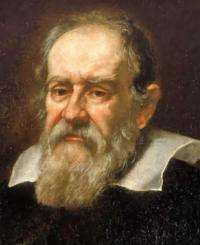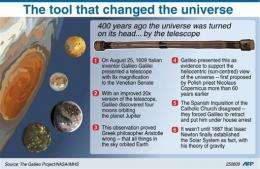Paradigm shift: How Galileo's spy glass upended science

Today it would hardly pass muster as a child's plaything, but the telescope Galileo used 400 years ago this week to peer into the heavens overturned the foundations of knowledge, changing our perception of the Universe and our place in it.
Galileo's "optick tube" magnified a meagre nine-fold and was not even conceived for astronomy.
Indeed, when the gadget was first demonstrated, Venetian senators were so smitten with its military potential that they doubled Galileo's salary and awarded him life tenure in the city-state's most prestigious university.
But when, in late October 1609, the 45-year-old Italian mathematician pointed his newfangled instrument -- essentially two lenses aligned in a tube -- skyward, what he glimpsed would unleash a scientific revolution and a rare "paradigm shift" in thought.
"He immediately made several surprising discoveries that contributed to the demise of the Earth-centered cosmology that had dominated Western thought for two millennia," says Robert Joseph, a professor of astronomy at the University of Hawaii.
Using ever-more powerful telescopes over the next year, Galileo observed that the Moon was not perfectly smooth as claimed by Aristotle but cratered and mountainous.
He spotted hundreds of stars previously untouched by human eyes.
More critically, he discovered the four inner satellites of Jupiter -- still known as the "Galilean moons" today, in his honour -- and learnt that Venus, Earth's closest planet, goes through a full range of phases.
Put together, his observations validated the revolutionary theory of Nicolaus Copernicus that Earth orbits the Sun, and not the other way round.

Galileo understood the implications of what he had seen, but the Catholic Church was not ready to accept such heresy.
Only in 2000 did the Holy See apologise for putting Galileo on trial in 1633, forcing him to recant his ideas lest he face imprisonment or worse. The Vatican also paid tribute to him in an exhibition that opened this month.
But resistance to a solar-centric view was not only religious.
The ancient Greek notion that Earth was at the centre of the cosmos was also a deeply ingrained scientific dogma, and it took decades to dislodge it.
Even the notion that "we can improve on our senses" by magnifying our vision was considered taboo, says Jerome Lamy, a French science historian at the Paris Observatory.
The concept of paradigm shifts was first articulated by US philosopher Thomas Kuhn in a 1962 book, "The Structure of Scientific Revolutions".
A sea change in thinking entails not only the overturning of a theory but the creation of an entirely new world view, he said.
It happened again at the start of the 20th century, only a few years after Scottish mathematician Lord Kelvin had famously declared there was "nothing new" to be discovered in physics.
That seismic shift came in the form of a short paper on special relativity by a German-born patent-office worker by the name of Albert Einstein.
Again, it did not happen overnight. But Einstein's ideas eventually toppled laws of physics that had prevailed for three centuries.
Some scientists say that we may be on the edge of yet another such turning point as the world's biggest atom smasher, the Large Hadron Collider (LHC), gears up to search for a theoretical sub-atomic particle that could explain how matter acquires mass.
"Dark matter" and "dark energy" deemed to account for 96 percent of the cosmos are other theorised puzzles.
If the LHC answers them, it could once again throw science into a period of fruitful crisis before a new consensus emerges.
German nuclear physicist Max Planck understood that old theories die hard.
"A new scientific truth does not triumph by convincing its opponents and making them see the light, but rather because its opponents eventually die," he wrote.
(c) 2009 AFP


















